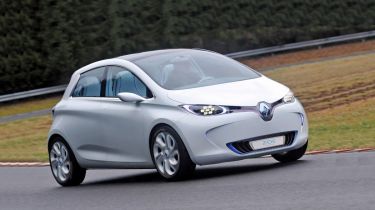Renault ZOE
We take an exclusive first drive in Renault's stunning Paris concept to get a glimpse of the firm's electric future.

Renault has invested heavily in electric technology, so the ZOE needs to be a sales success. Fortunately, it’s the most desirable EV we’ve driven yet, with bold styling, intelligent interior design and a low entry price. Electric cars are inherently smooth and quiet, so the Zoe will be among the most refined superminis around. But we’ll have to drive a production version before delivering our definitive verdict.
The electric revolution is well underway at Renault! This is the ZOE, one of four battery-powered models set to launch in the next 18 months, along with the Fluence Z.E., Kangoo Z.E. and Twizy. Its futuristic design previews the next Clio – and Auto Express got an exclusive opportunity to drive it.
In the metal, it looks surprisingly aggressive for such a small car although, at 4.1 metres long, it’s larger than the current Clio. A wide, dark grille and swooping LED headlights, both inspired by the DeZir concept, give it real presence. There are some lovely details, too, such as the multi-layered bumper finished in Blue Chrome, and 19-inch white and chrome alloys.
Inside, swathes of white fabric and a panoramic glass roof make it light and airy. There’s plenty of room for four adults, and even a decent boot, as the lithium-ion batteries are hidden inside the chassis to help save interior space. The car we drove is a priceless one-off, so we couldn’t push it to the limit on the track. But at low speeds, it’s reassuringly simple to operate. There are no gears to worry about, and you soon get used to the silence as you pull away.
The electric motor provides 222Nm of torque from zero rpm, which translates to a lively 0-62mph time of only 8.1 seconds. The regenerative brakes cut in when you take your foot off the throttle, so you don’t always need to use the pedal. This is ideal for smoothing out the constant slowing down and speeding up in city traffic.
Despite the space-age looks, Renault promises that, on the outside at least, the concept is around 90 per cent faithful to how the finished version will shape up. However, some of the showy interior touches are unlikely to reach production. So don’t expect to see the ‘mood screen’ panel behind the touch-sensitive display, which constantly pulses different colours to calm the driver, the huge panoramic roof, or air-con that automatically adjusts humidity and releases perfume. But the touchscreen control panel could be enlarged for the showroom model.
Charging the ZOE is as fuss-free as driving it – the prominent blue badge in the nose flips open to reveal a plug-in point. It takes up to eight hours to top up from a standard socket, but a higher-voltage fast-charge can give you an additional 37 miles in only 10 minutes, or an 80 per cent capacity in 30 minutes.
Renault also claims it is possible to change the entire battery pack in a mere three minutes. The shape and exact position of the battery pack is still a secret, though, until the finished car arrives next year.
The most ambitious part of the ZOE is not the design or the electric drivetrain, but the price. When it goes on sale this time next year, the car will cost the same as the equivalent Clio diesel – less than £15,000, once the £5,000 Government subsidy has to be taken into account.
Although customers will have to pay around £65 a month to lease the battery from Renault, that relatively low price means this technology is becoming increasingly accessible to the average driver, and the manufacturer is quietly optimistic that it will outsell most of its electric rivals. From our time spent with the car, it’s easy to see why.







